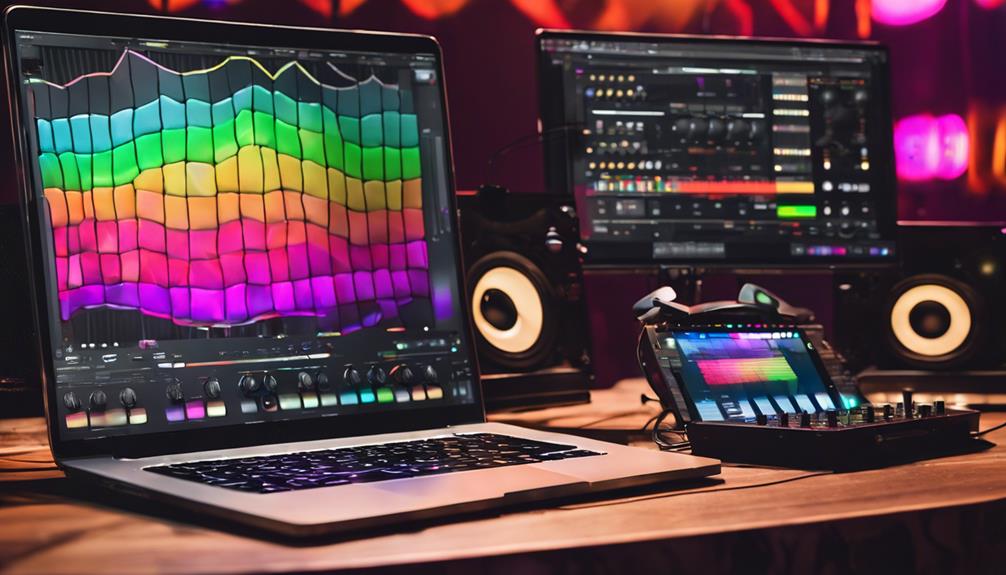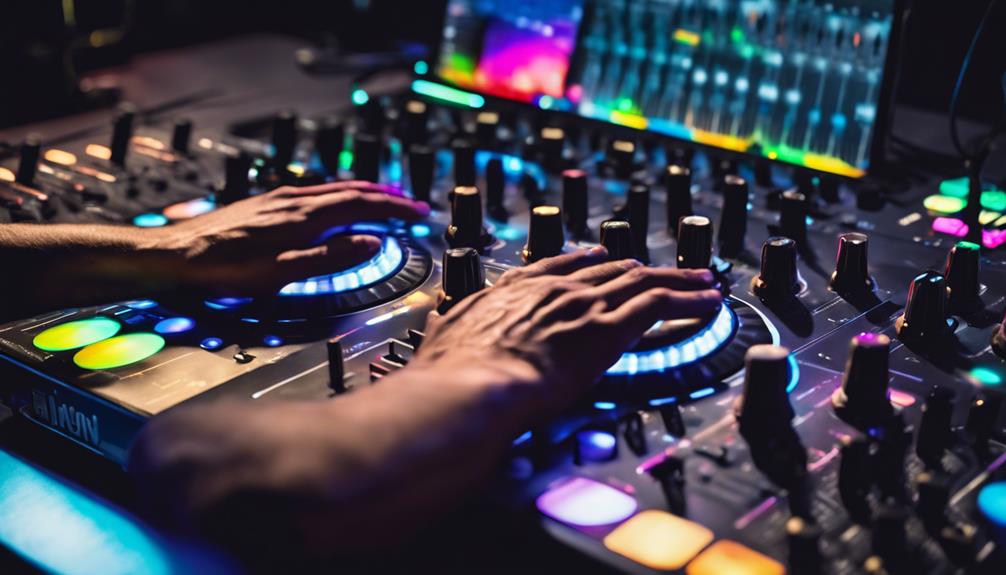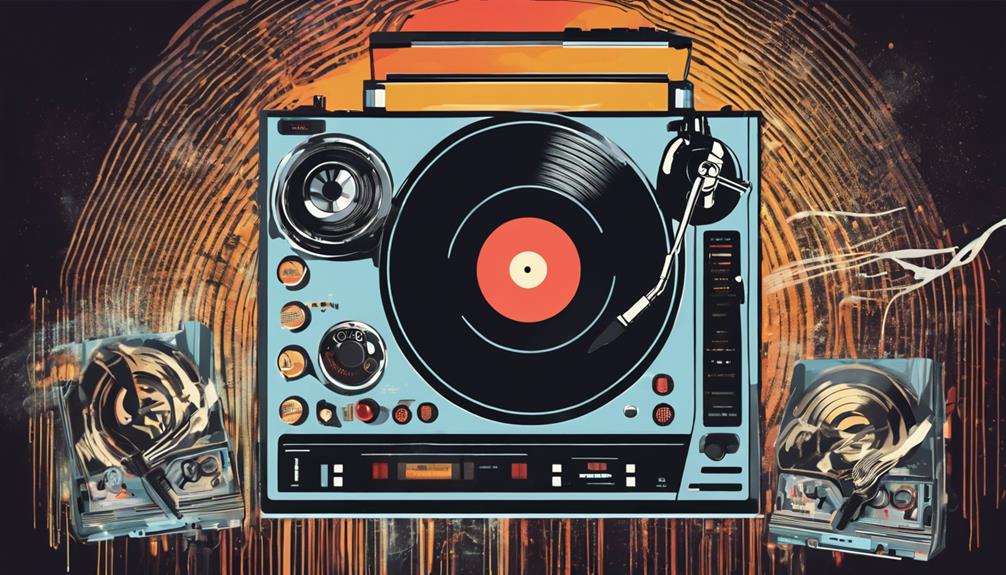No products in the cart.
First, confirm your DJ controller’s compatibility with the DJ software by consulting the official compatibility list and verifying the MIDI and firmware specifications. Next, install the necessary drivers for your controller, which you can find on the manufacturer’s website; this guarantees smooth communication between the hardware and software. Configure your audio settings by adjusting the sound card to match the controller’s audio interface and calibrating audio channels and buffer size to minimize latency. Regularly update both the software and firmware to maintain efficiency and incorporate new features. Finally, if you encounter connection issues, troubleshoot by checking USB connections and retesting the controller setup. Progressing through these steps systematically will reveal further insights.
Contents
hide
Key Takeaways
- Confirm controller compatibility with your software by checking the official compatibility list and verifying MIDI capability.
- Install the latest drivers from the manufacturer’s website specific to your controller model and operating system.
- Configure audio settings in your DJ software, ensuring the correct audio device and channels are selected, and adjust buffer size and sample rate.
- Regularly update both your DJ software and the firmware of your controller to enhance functionality and stability.
- Troubleshoot connection issues by checking USB ports for security, restarting your computer, and testing the controller on another system if needed.
Verify Controller Compatibility
Before connecting your DJ controller, it’s important to check the software’s compatibility list to guarantee smooth integration. You’ll want to visit the software’s official website where they typically list compatible controllers. This step ensures that the controller you’re using is supported, avoiding potential connectivity and functionality issues down the line.
Next, it’s vital to verify the controller’s MIDI capability. Since MIDI is the protocol that allows devices and software to communicate, confirming this can prevent a lot of headaches. You should specifically check the firmware version of your controller. Manufacturers often update firmware to enhance compatibility or add new features. If your controller’s firmware isn’t up-to-date, you might face compatibility issues with newer software versions.
Additionally, you should research controller mapping. This involves understanding how your controller’s controls are assigned to functions within the software. Sometimes, even if a controller is technically compatible, the default mappings mightn’t align with your needs or preferences. Online forums and user reviews can be invaluable here, offering insights into how well a controller integrates with specific software, based on real-user experiences. This research will guide you in either selecting the right controller or adjusting its settings for best performance with your chosen software.
Install Necessary Drivers
In order to guarantee seamless interaction between your DJ controller and software, you must download and install the latest specific drivers from the manufacturer’s website. Drivers facilitate important communication pathways between your hardware and software, ensuring that each component functions effectively together. Without the right drivers, your software mightn’t recognize the controller, leading to potential performance issues or even operational failure.
You’ll need to navigate to your controller manufacturer’s website and locate the drivers section. Here, make sure you select the drivers that correspond to your specific controller model and your operating system. Downloading the incorrect driver can lead to compatibility issues, disrupting your setup process.
Installation must be approached methodically. Follow the provided instructions meticulously to avoid common pitfalls. Once installed, it’s essential to regularly check for driver updates. Manufacturers often release updates to enhance functionality, patch security vulnerabilities, and optimize overall performance. Keeping your drivers up-to-date isn’t only a troubleshooting technique but also a proactive measure for performance optimization.
Configure Audio Settings
Having installed the necessary drivers, you’ll next need to configure the audio settings in your DJ software to guarantee top performance and accurate sound output. Start by adjusting the sound card settings to align with your DJ controller’s audio interface specifications. This guarantees that the audio signal routing is optimized, preventing any delays or distortions in sound.
Next, you’ll want to select the correct audio device in the software preferences. This step is essential for seamless software integration and ensures that your controller communicates effectively with the DJ software. Without this alignment, you might face connectivity issues or subpar audio output.
It’s also important to set up audio channels for each deck or input source correctly. This setup enables efficient mixing and precise monitoring, critical for live performances. Controller mapping plays a pivotal role here, allowing you to assign and control these channels directly from your DJ controller.
Lastly, don’t forget to calibrate your audio buffer size and sample rate. These adjustments are crucial for minimizing latency, ensuring that the audio output isn’t only high quality but also in sync with your mixing actions. Proper mixer configuration can enhance this process, leading to an overall robust and responsive DJ setup.
Update Software and Firmware
For peak performance and access to new features, you should regularly update your DJ software and controller firmware. This practice not only guarantees compatibility with the latest enhancements but also integrates crucial bug fixes, performance improvements, and new functionalities. Regular updates optimize your setup, making your DJing seamless and more efficient.
When you update your software, you’re not just keeping up with the latest technology; you’re also proactively troubleshooting potential issues that could disrupt your performance. For instance, if your software or firmware becomes outdated, you might find yourself facing compatibility problems that impede the communication between your controller and the software. These updates often contain fixes that resolve these issues before they become a major headache.
Moreover, the benefits of updating your system are substantial. They can greatly enhance the stability and functionality of your equipment, allowing you to utilize advanced features that can improve your DJing skills. Additionally, firmware updates often open up new capabilities in your controller, giving you a competitive edge.
To stay ahead, you’ll want to check for updates periodically. Follow the manufacturer’s instructions carefully to make sure that each update is installed correctly, maximizing the potential of your hardware and software.
Troubleshoot Connection Errors
After ensuring your software and firmware are up to date, you might still encounter connection errors that require further troubleshooting. First, check USB connections meticulously. Confirm that the USB ports and cables are secure and undamaged, as a loose or faulty connection can prevent your controller from being recognized by the computer. It’s vital to verify that the port itself isn’t malfunctioning—try connecting through a different USB port to rule out this possibility.
If problems persist, restart your computer and reconnect the controller. This can resolve issues where the controller isn’t recognized due to temporary software or hardware glitches. Additionally, troubleshoot controller settings within your DJ software. Confirm that the correct device is selected and that no conflicting settings are causing connectivity issues.
For a deeper analysis, test the controller on another computer. This step can help you determine if the problem lies with the controller or your primary computer. If the controller works on a different computer, the issue may be specific to your computer’s hardware or operating system settings.
Lastly, if these steps don’t resolve the issue, consider updating the controller’s firmware as per the manufacturer’s instructions. Firmware updates can fix bugs and enhance compatibility with updated software versions, thereby smoothing out connection issues.
Frequently Asked Questions
How Do I Connect My DJ Controller to My Software?
To connect your DJ controller, first verify hardware compatibility and proper driver installation. Connect via USB, configure settings in your software, and confirm communication by testing the system’s responsiveness to controls.
How to Connect DJ Mixer to Computer?
To connect your DJ mixer to a computer, use a USB cable for data transmission. Confirm mixer compatibility and install necessary audio interfaces. Properly configure your software settings to handle audio signals effectively.
Do You Need Software for DJ Controller?
Yes, you need software for your DJ controller to operate effectively. It guarantees controller compatibility and activates advanced features. Explore software alternatives to find the best match for your controller’s capabilities and needs.
How Do You Connect DJ Instruments?
To connect DJ instruments, you’ll start by ensuring hardware compatibility. Use a USB or explore wireless options for connectivity. Always verify that devices communicate effectively, adjusting settings for peak performance and precision.
Conclusion
In wrapping up, make sure your DJ controller is compatible with your software. Always install the latest drivers to facilitate seamless communication.
Properly configuring your audio settings is essential for best sound output. Regularly update both software and firmware to enhance functionality and stability.
If you encounter connection issues, systematically troubleshoot to isolate and resolve errors. Following these steps will greatly improve your setup’s reliability and performance, enabling a smoother DJing experience.




